how to use gouache watercolor
What is gouache painting and how do you use it? This type of medium is not that well-known; however, it is extremely versatile and easy to apply. Painting with gouache is comparable to both watercolor and acrylic paints. All of them are water-based mediums, and you will be able to create many gouache painting ideas. So, if you would like to find out a little more about gouache, read on and discover all about the many amazing gouache painting ideas and techniques.
- 1 What is Gouache Paint?
- 1.1 Gouache Versus Watercolor Paints
- 1.2 Gouache Versus Acrylics
- 1.3 Gouache Comparison Table
- 1.4 Best Gouache Painting Set: ARTEZA Paint Set
- 2 Is Gouache Paint Toxic?
- 3 Gouache Techniques
- 3.1 Altering Dry Areas
- 3.2 Applying a Dry Brush Effect
- 3.3 Glazing Technique
- 3.4 Gouache Mixed Media
- 3.5 Applying Wet-On-Dry
- 3.6 Applying Wet on Wet
- 3.7 Layering Gouache
- 3.8 Experimenting With Gouache
- 3.9 Forming Blooms
- 3.10 Creating Dimension
- 4 A Step-by-Step Gouache Painting Tutorial
- 4.1 Create a Workspace
- 4.2 Experiment First
- 4.3 Plan Before Painting
- 4.4 Mixing Colors
- 4.5 Adding Dimension
- 4.6 Adding Details
- 5 Gouache Painting Tips
- 6 Frequently Asked Questions
- 6.1 What Is Gouache Paint?
- 6.2 What Is Gouache Paint Used For?
- 6.3 Can You Use Gouache With Acrylics?
- 6.4 What Paper Can You Use With Gouache?
- 6.5 What Brush Is Best For Gouache?
What is Gouache Paint?
As we have mentioned, gouache is water-based and contains either natural or synthetic pigments that are combined with Arabic gum and water. Sometimes, manufacturers will also include chalk for added body. Gouache painting is quite useful in that you can use it to produce transparent watercolor effects when thinned with water. However, the gouache paints are normally thick as they contain more pigment than watercolors, and can therefore work similar to acrylics, producing an opaque painting with vivid colors. This makes gouache a popular paint with illustrators, versatile and easy to use while providing bold and beautiful colors. However, if you are looking for a more transparent look, watercolors might be your best option.
Gouache can be used on watercolor paper with watercolor brushes, so materials are easy to come by. You will notice when applied, the gouache is more opaque, and the white paper will not show through as with watercolors.
The paints can also be used to apply colors from light to dark, and dark to light without problems. Unlike your watercolor and acrylic paints. Also, instead of masking areas off, you can paint in white with gouache paint. The gouache paints can be used as acrylics; however, you can rework the dry gouache paint, unlike the acrylic paints that you cannot change. The main types of gouache paints include your artist or professional grade paints and student grade paints. The artist-grade gouache costs more, but the quality is superior to the students' grade. So, for beginners or kids, purchasing a student-grade gouache product is more affordable yet still offers good quality.
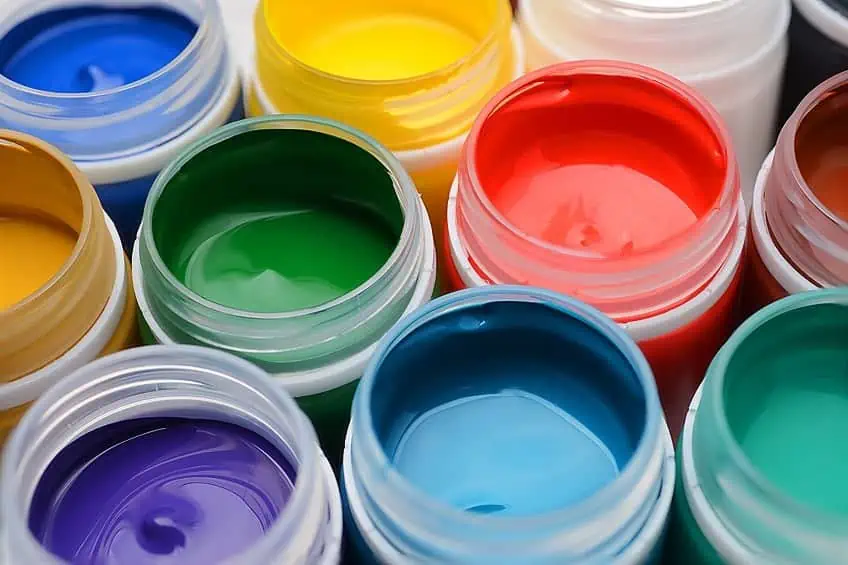
Gouache Versus Watercolor Paints
Even though watercolors and gouache are made with similar ingredients, gouache has a much higher pigment ratio than watercolor paints, and to add more texture and opaqueness, chalk is sometimes added. Gouache is, therefore, denser, and opaque when compared to transparent watercolor paints. Only by adding water to the gouache paint, can you begin to achieve a more translucent effect. Both watercolors, as well as gouache, use water when painting. However, gouache is much thicker in consistency, while watercolors are fluid.
Gouache dries faster than watercolors and mistakes can easily be fixed. A gouache painting can be reactivated by adding water, so you can work on a specific area again. Watercolors blend easily, as they begin to bleed into each other as soon as they touch the paper, which can also create mistakes if the painting is not planned out correctly, to begin with. Watercolor paints need special watercolor paper as the normal paper is too thin and will buckle. Gouache, on the other hand, can be applied to most types of paper without problems, including watercolor paper. Since gouache is thicker, and if applied in too thick layers, can dry and crack.
Both types of paint require a slightly different hand. For example, when layering the paints, you need to layer watercolor paints from light to dark. Whereas gouache you can do from light to dark or apply dark and work to lighter shades. Also, to lighten paints, you simply add water to watercolors, while white paint is needed for gouache.
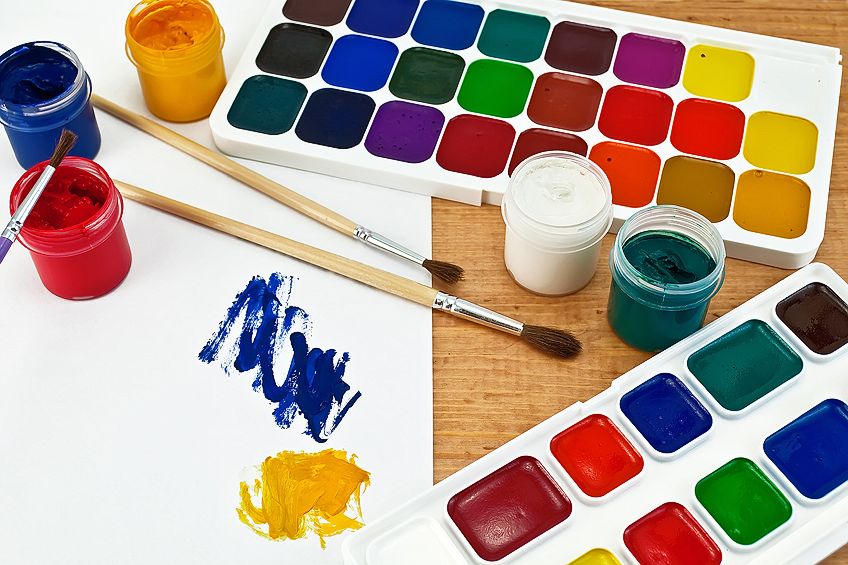
Gouache Versus Acrylics
To start, acrylics and gouache have different binders, acrylics use an acrylic polymer, while gouache uses Gum Arabic. Both are water-soluble and can be cleaned without difficulty using water. However, acrylics are water-resistant when dry and become more flexible. Applying a too thick layer of gouache, in contrast, you will run the risk of it cracking. Acrylic paints are more durable in that they can withstand light exposure better. However, once it has dried, the paint cannot be reactivated. Gouache, on the other hand, can be reactivated and reworked but is less resistant to light and dust. So, if you display your painting with gouache, it should be framed and mounted behind glass for protection.
Acrylics have a glossy and opaque look when dry, while gouache has a softer, matte, opaque appearance. You can use most papers for gouache; however, you cannot use them on other surfaces like metal or plastic. Acrylics are a little more versatile in this, as they can be applied to a variety of surfaces including paper, metal, plastic, and wood. Both mediums use a paintbrush for application, but you can also use other tools like a palette knife with acrylics. Overall, gouache is a lot more like watercolors than acrylics in makeup, the common thread being that they are all water-soluble.
Gouache Comparison Table
Below is a table with a few of the comparisons between gouache, watercolor, and acrylic paints. It is also possible to combine the use of gouache with both watercolors and acrylics for different effects. Watercolors can be mixed or used with watercolors, while acrylics and gouache can be mixed to form an acrylic gouache.
| Gouache | Watercolors | Acrylics | |
| Pigment Ratio | Higher pigment ratio | Lower Pigment ratio | Depending on the type, high pigment load |
| Consistency | Thick | Fluid | Thicker than gouache |
| Binder | Gum Arabic | Gum Arabic | Acrylic polymer emulsion |
| Appearance | Opaque – Matte | Transparent | Matte, glossy, or satin finish |
| Surfaces | Can be used on different types of paper | Must only use on watercolor paper | Can be used on a variety of surfaces from paper to metal and more |
| Drying | Dries fast | Contains more water and dries slower | Dries faster than gouache |
| Application | Can be applied from light to dark and dark to light | Can only be used from light to dark | Depending on what you want to achieve, you can use both |
| Mistakes | Mistakes can easily be covered up | Difficult to fix mistakes, if at all | Can be fixed, easier when still wet |
| Blendability | Less blendable | Blends easily | Difficult |
| Dry Colors | Dark colors tend to lighten and lighter colors may appear darker (mostly on larger areas) | Dries lighter | Dries darker |
Best Gouache Painting Set: ARTEZA Paint Set
The Arteza Gouache Paint set is an affordable option for both the beginner artist as well as the professional. This particular set comes in 60 vibrant colors; however, you can also purchase a 24 color set. The paint formula is non-toxic, so can safely be used by everyone including children. The richly pigmented paints provide a matte and opaque finish. You only need a small amount of thick paint for good coverage. The paint dries fast, however, you can reactivate by adding water if you need to. This paint set truly offers amazing quality at an affordable price.

- Packed with so much pigment that they are densely opaque and have a matte finish
- The thick nature of these paints allows for maximum coverage
- Paints dry quickly on your chosen canvas but can be reactivated with water
View on Amazon
PROS
- Wide color selection
- Vibrant colors
- Excellent coverage
- Affordable
- A tiny amount goes a long way
CONS
- Thick paint may create streaks
- Might dry too fast for some
- Some users found it difficult to blend and layer the paint
Is Gouache Paint Toxic?
Gouache is usually made from a combination of pigment, a binding agent, and water. In most cases, all these ingredients are natural and not harmful, however, some products may contain harmful ingredients. Paints can include things like additives, fillers, or other chemicals that can be considered unsafe. So, the best way to make sure you are getting a non-toxic product is to always check the labels to see what is inside. Avoid products that include ingredients like xylene, benzene, or formaldehyde as these can be toxic.
Most pigments are natural and safe to use, however, there are pigments that you should take note of. You might find that paint contains cadmium or other lead-based pigments, which should be avoided. You should not have a problem with finding non-toxic gouache products, but again, always check the labels. Gouache is a much safer option when compared to acrylics and oil paints.
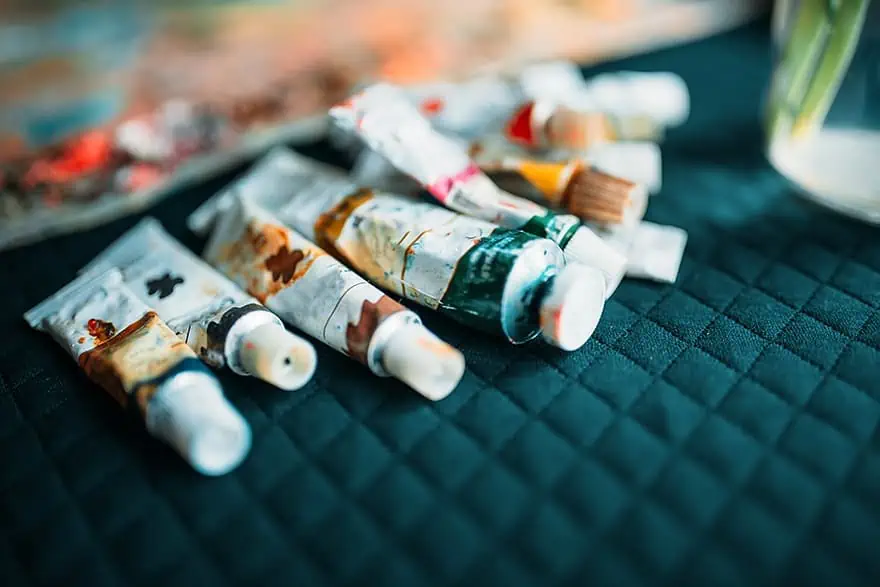
If you are looking for paint that you can use on your skin, make sure to choose a specialty product that is specifically designed for this purpose. Never use paint, even gouache on the skin. However, if you simply mess a little paint on the skin, it is easy to remove with a little soap and water. Removing gouache from clothes is just as easy, using some warm water, soap, and a sponge. Although, it is always best to remove any paint from your skin or clothes while it is still wet.
Gouache Techniques
So, what is gouache paint used for? Gouache paints are quite versatile as they can either be used to create a watercolor effect or produce a more opaque acrylic paint effect. Easy to use and clean, it is popular among many artists including graphic designers, illustrators, and all kinds of painters. As with any art medium, there are various methods you can use to produce different effects. Below are a few gouache techniques that hopefully inspire you to go out and create your own unique approach.

Altering Dry Areas
Gouache paints dry quickly and can be revived once dry. Once the paint has dried, you can simply use a wet paintbrush to rehydrate the paint. You are then able to rework that area. You can easily soften edges and create gradients between strokes with this effect. For example, once you have painted two colors or strokes, wet your paintbrush, and apply it to one of the dry colors. Then pull the color into your second color and blend. You might need to experiment with colors to what gradients and effects you can achieve.
Applying a Dry Brush Effect
This is quite easy to do, simply dip your brush into the paint and wipe the brush, removing most of the paint. You can wipe the brush on your palette, or you can use a rag or paper towel. Next, take the brush and apply the leftover paint. This technique provides a tonal effect, where you have more solid colors and areas with less color, where areas of paper come through. This gives you a textured look and is great when trying to create highlights and backgrounds.
Glazing Technique
As mentioned, gouache dries quickly but can be diluted to create a more translucent effect. You can use this to add layers to dry areas of paint, which is known as glazing. By adding a more translucent layer over the dry paint, it enhances and produces a richer color. You can also use the technique to create deeper shadows by varying the intensity of the diluted paint. You can also use a staining effect, which is a good way to cover a large area with paint and provides a base from which you can work. By simply adding water, you can imitate watercolor effects.
Gouache Mixed Media
You can experiment and try using gouache with other art media. Try using it with markers, watercolor pencils, or charcoal. You can also try using or mixing watercolors or acrylic and gouache to see what happens.
Applying Wet-On-Dry
Gouache has a thicker and more creamy texture, so it should go onto dry paper smoothly. The paint should then produce an opaque and matte appearance. You can add a small amount of water to create a more fluid application.
Applying Wet on Wet
Applying your paint to dry paper is simple, with this technique, you can apply paint to wet paper. Dampen the paper and then apply your paint. The paint should spread and produce softer edges. This can be used to great effect for creating horizons and landscapes.
Layering Gouache
Applying opaque layers will cover underlying layers of paint, this is the same effect acrylic paints offer. You will use less water when applying your gouache paint. Wait for your base layer to dry before applying another layer. As gouache can be reactivated with water, if you do not wait, the next layer can bleed into the base layer and will muddy the color.
Experimenting With Gouache
What is gouache paint used for? This question is an open book as you can experiment in many ways with how you use the gouache paint, try to come up with unique effects. For example, instead of using a paintbrush, apply paint with a sponge, toothbrush, scrunched-up paper, or any other way you can think of. This will create a unique look to your painting. Why not try painting on colored paper? You can create different results by applying paint to different colored papers.
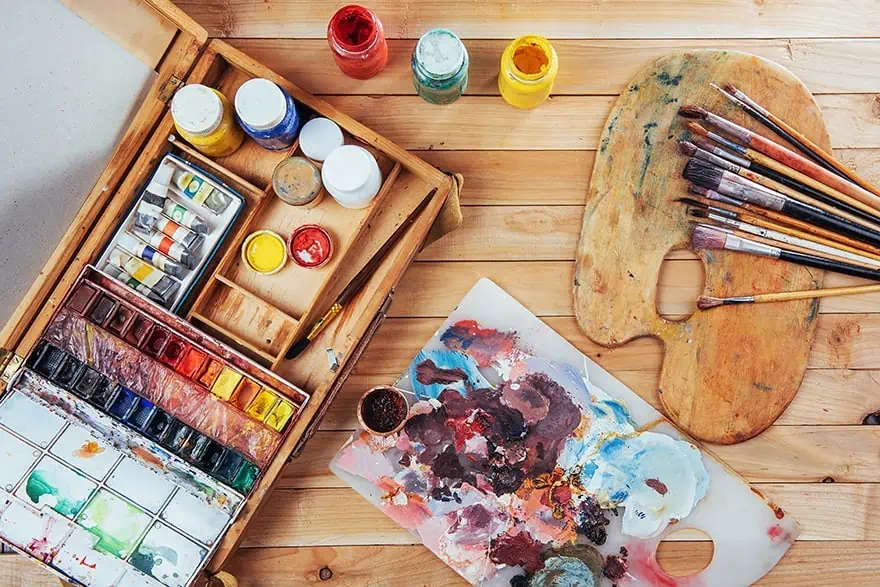
Forming Blooms
This is using gouache as you would watercolors, by loading the brush with water and then a little paint. This is then applied to the paper, the brush is again loaded with water and another color and blotted onto the paper, forming little puddles of color that spread over the paper.
Creating Dimension
To do this, you must apply different color values to areas that reveal parts that are in the light and others that are in shadow. Choose one basic color and some white paint, also create a mid-tone by combining a little of both colors. Take the white paint and add this to the area, next apply some white paint to which a little color has been added. Next, use your mid-tones and as you move into shadow, keep adding more of your basic color until you reach the darkest value.
A Step-by-Step Gouache Painting Tutorial
How to use gouache paint? Well, the first step is to get all the necessary materials together. You can get gouache paints that come in either tubes or trays. If you are starting, it is good to get a few primary colors, white and some black paint to create various shades. There are also some good and affordable gouache sets available that come in a variety of colors. However, if you want to try a few brands out, buying the individual tubes might be best.
You can also get a palette for mixing, one that is indented and not flat. You can purchase some brushes, try getting a few different sizes. Watercolor brushes can also be used, and these can either be synthetic or natural brushes. You can also choose to work on watercolor paper or canvas. Of course, you will also need some clean water when working with gouache. What is next for painting with gouache? Follow this simple gouache painting tutorial.
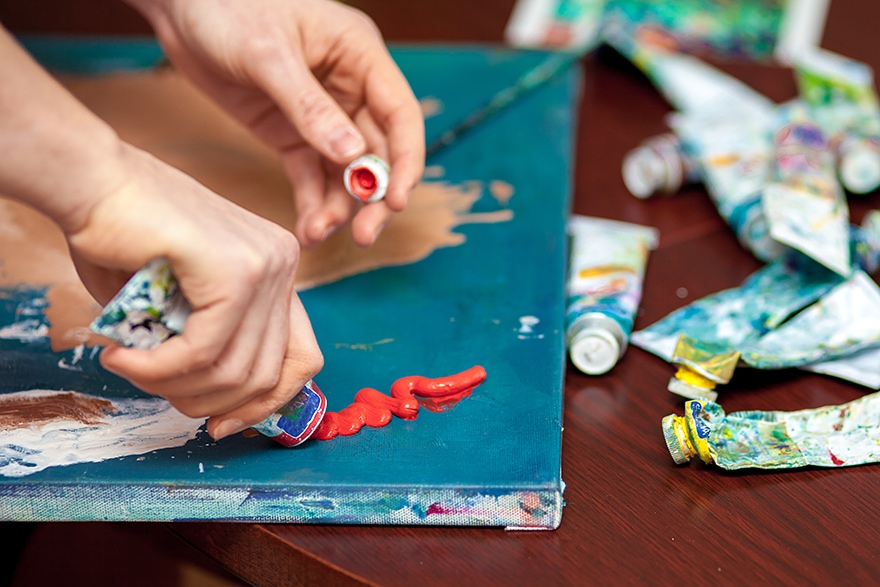
Create a Workspace
You should always have a space to work in, where you will not be distracted or disturbed. Since gouache is water-based, you do not have to worry too much about ventilation as you have to with oil paints. Gouache is also easy to clean up, so if you do make a few splatters onto the floor or elsewhere, it should be easy to remove. However, you can place some newspaper down onto your work surface. Place a cup filled with water nearby as well as a spray bottle with water and some paper towels. Preferably, use a cup that is disposable and not one used for drinking purposes.
Experiment First
Plan and layout your whole painting project, so that you can avoid any mistakes as you paint. If it is your first time using gouache, consider first experimenting and learning how to use gouache paint before you attempt a specific art piece. Begin by squeezing your chosen colors onto your palette. Place your brush into the paint and apply to your surface, then dip your brush into the water and then the paint before applying to your surface.
Notice how the paint reacts when adding water and when using without water. You should see more transparency, similar to watercolors when diluting the gouache paint. Always add your paint first and then the water, and make sure to add a little water at a time until you get the consistency you are looking for. Play around and apply the different techniques mentioned above.
Plan Before Painting
As mentioned, planning is important to prevent making mistakes. To make it easier, you can consider drawing in your design first. Using a graphite pencil, draw your design onto the surface before painting. This helps to give an overall picture of what you would like to achieve. Once this is done, you can then paint in areas that require white paint. You can use white oil paint, as this helps to repel any gouache paint and the area will remain white. However, you can also use a thick layer of white gouache that should be left to dry before painting further.
If you do not have any white areas, you can start by laying down a base color. Lay down a thin layer of basic color and fill in the chosen colors for your design, painting the sketch areas done beforehand. For example, blue for the sky and green for grass areas. Before painting, add a few drops of water to the paint so it goes onto the surface more smoothly.
You can choose to add only one or two layers of diluted gouache, for a watercolor effect, however, you can add more layers for added dimension. Take note, that if you apply the gouache too thick, it can begin to crack once it dries.
Mixing Colors
When mixing colors, always clean your paintbrush with water before using another color or use a clean brush. You can squeeze paints you wish to mix directly onto your palette and then blend with your brush. You can also use your brush to dip into the paint and place it on the palette, then clean the brush and do the same with another color and blend. The gouache paint is quite thick, so you can also try blending colors directly on the paper or canvas. You can produce slight color changes, which is perfect if you are trying to paint realistic images. You can create a variety of colors and shades by only using your primary colors as well as some white paint.
When mixing colors, you can include a little Gum Arabic if you have diluted your paint too much. Adding the Gum Arabic will help bind the color to the paper surface. Not only that, but it can also produce other effects like increasing gloss once the paint has dried and created a more vibrant color.

Adding Dimension
You will need to make sure your first layer of paint is dry before moving on because if it is still wet, the paint will bleed into each other which can create a muddy color and things could get out of control. Although you can paint wet-on-wet, it is a technique that calls for some practice. However, if you do not want your paint to dry too fast, simply spray with some water to keep it damp. This is useful in a dry and hot climate.
Next, you can now add some dimensions by shading in selected areas. The simplest way to do this is to apply a row of similar colors from light to dark to form a gradient. Take a green apple, for example, start with a pure green line, and then add a line that has some green with a small amount of white or gray. Then, carry on adding white or gray until you reach your darkest color value. You can then load your brush with water and wipe it on a rag or paper towel to remove any surplus water. Next, use the brush to gently blend the color lines. You can also use stippling or cross-hatching to create shaded areas. Use a damp brush to gently go over the area to soften the effect.
Adding Details
To add details, you can use a small brush. For example, use a thin smaller brush to add details to leaves. You may also want to outline your work, and for this, you can use a small brush with black paint, or you can also use a marker pen. Once your painting is dry, go back and apply any finishing touches that you think are needed. You can frame your work, placing it behind glass for protection.
Gouache Painting Tips
We hope the gouache painting tutorial was helpful. However, the best way to learn gouache painting is to practice. Luckily, many artists have already gone through the learning process and have discovered what works best. So, here are a few tips on how to use gouache paint.
- If you are going to work for a long time, make sure to keep your brush moist and have a spray bottle handy as gouache paint dries quickly
- When changing colors, make sure to clean your brush properly. Wipe off on some paper towel or rag and place into clean water. You can also use a different clean brush
- Avoid applying gouache too thick to avoid the paint from cracking when dry
- There are many paint colors available, however, using only your primary colors plus white and black to create a variety of shades of color
- Try out different brands
- If you are looking for the best quality, avoid using student-grade paints that may contain fillers. Rather choose your artist-grade paints
- If you are painting in a hot and dry climate, to keep the paint moist, squeeze it onto a moist paper towel. Keep moist with a spray bottle
- The perfect consistency of gouache should be creamy, having an easy and smooth flow from the brush
- Create color charts to plan better for future projects
- Synthetic brushes work better than natural brushes as they hold less water. Synthetic brushes may also leave fewer streaks
- Start small when painting with gouache using a limited color palette, until you feel more confident trying out a larger project
- When layering the gouache paint, always make sure the base layer is dry before you carry on painting. Waiting only takes a few minutes and makes sure the top layer does not bleed into the base layer
- Even though you can work from dark to light, it is best to paint from light to dark. Also, start from a thinner consistency and moving onto thicker layers
In conclusion, you can create some amazing art pieces using gouache paint. However, the most important thing is to enjoy what you are doing. So, do not get too involved with all the technicalities of painting, just keep on practicing, and have fun.
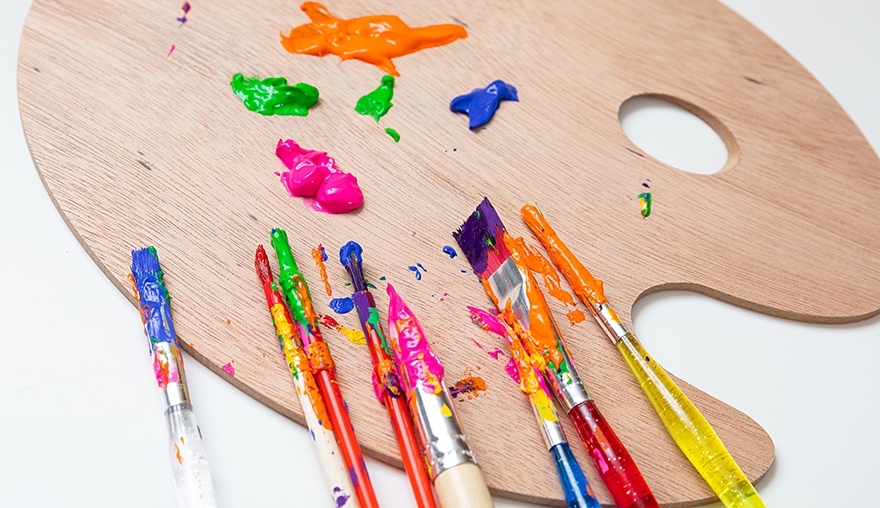
Frequently Asked Questions
What Is Gouache Paint?
This type of paint is a water-based medium that contains a natural pigment, a binder, and some water. The paint is thicker than watercolors and offers a more opaque, matte finish. Gouache offers vibrant colors that are fast drying and can be used to create a variety of effects.
What Is Gouache Paint Used For?
The creamy, smooth, vibrant, and opaque colors of gouache make it popular for use with commercial artists, graphic designers, illustrators, and art students. The paints are easy to use and offer a similar effect to watercolors and acrylic paints, making them extremely versatile.
Can You Use Gouache With Acrylics?
Yes, the most popular way is to use an acrylic gouache. This paint dries fast and has a creamy consistency. You can easily layer the paint and can provide the best of both paints. However, the acrylic gouache cannot be reactivated with water.
What Paper Can You Use With Gouache?
Gouache is quite versatile and can be used on most paper as well canvas, and even be used on wood. However, the best paper would be watercolor paper or a paper that is specially made for gouache paint.
What Brush Is Best For Gouache?
You can paint with both a natural as well as a synthetic brush. However, many artists recommend using a synthetic brush as it holds less water. You can also use a soft to a medium paintbrush, something in-between soft and medium would be ideal.
how to use gouache watercolor
Source: https://acrylgiessen.com/en/how-to-use-gouache-paint/
Posted by: smithsuffee.blogspot.com

0 Response to "how to use gouache watercolor"
Post a Comment